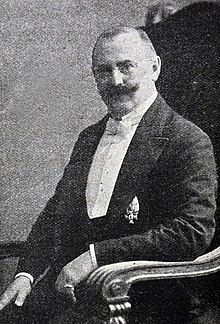Siegfried Translateur
Siegfried Translateur | |
|---|---|
 | |
| Born | June 19, 1875 |
| Died | March 1, 1944 (aged 68) |
| Nationality | German |
| Occupation(s) | conductor, composer, music editor |
| Notable work | Wiener Praterleben |
Salo Siegfried Translateur, or Siegfried "Salo" Translateur, Template:Lang-he (19 June 1875 – 1 March 1944) was a German conductor and composer of waltzes, marches, and other light dance music.[1] Today he is most famous for his Wiener Praterleben [de] waltz, which became popular as Sportpalastwalzer in 1920s Berlin.
Biography
Siegfried Translateur was born in Bad Carlsruhe [de; pl] (Carlsruhe O.S.,[2] literally "Bath Charles's Rest"), in the Province of Silesia, Royal Prussia, German Empire (now Pokój, Template:Lang-szl (literally "peace, room, interior (in architecture)"), gmina Pokój [pl], in Poland), the natural son of Rosaline Translateur[3] (German pronunciation: [translatøːr, translatøːɐ, tʁanslatøːɐ]) (1858, Kośminek [pl], City of Lublin, Lublin Governorate, Congress Poland, Pale of Settlement, Russian Empire – 1934, Mährisch Kromau [de]) and an unknown father (c.1828–c.1888), and adopted child of her later husband, the ḥazzān Salomon Lagodzinsky (c.1857, [?] – 1915, Mährisch Kromau). He started his music studies in Breslau, Vienna, and Leipzig, and also learned from a French composer of dance music, Émile Waldteufel.[4] In 1900, he moved to Berlin, where he became an orchestra conductor.[1][5]
Translateur's entertainment music became increasingly popular; his orchestra played on international tours and even in the presence of Emperor Wilhelm II. In 1911, he founded the "Lyra" music publishing company in Berlin-Wilmersdorf. It mostly published his own works, but also compositions by José Armándola [de], Marc Roland [de], Franz von Blon and Paul Lincke, among others. Translateur's son Hans Translateur[6] later joined his father in the business, and the publishing house was renamed to "Lyra Translateur & Co".[5]
After the Nazi seizure of power in 1933, Translateur, having been deemed a "half-Jew" (Mischling) by the Nuremberg Laws, was forced to liquidate "Lyra", and was barred from the Reich Music Chamber which meant a professional ban. He sold his publishing house to the London publisher Bosworth in 1938. Not much is known about what happened to him after that. Translateur, along with his wife, was deported from Berlin to the Theresienstadt concentration camp on 19 April 1943.[4] He died there on March 1, 1944, at the age of sixty-eight.[1]
Works
Author of about 200 works, Translateur's most famous piece remains the Wiener Praterleben waltz (opus 12), which he wrote in 1892 at the age of seventeen[4] while attending the Vienna conservatory. It became widely known as the Sportpalastwalzer ("Sports Palace Waltz"), because it has been played regularly during the "Six-days" cycle races at the Berlin Sportpalast from 1923 onwards. Up to today, it is played at the current Velodrom track cycling arena.
Many of his works were titled in reference to a current event, such as the German warrior quadrille for piano, opus 45, and Automotive march for orchestra, Op 154.[5]
References
- ^ a b c "Siegfried Translateur (1875-1944)". Planet Vienna. Retrieved 2009-11-16.
- ^ gov.genealogy.net
- ^ geni.com
- ^ a b c "Siegfried Translateur". Bosworth. Retrieved 2009-11-17.
- ^ a b c "Siegfried Translateur @ LexM". Universität Hamburg, LexM. Retrieved 2009-12-30.
{{cite web}}: Italic or bold markup not allowed in:|publisher=(help) - ^ geni.com, [1], [2]
External links
- 1875 births
- 1944 deaths
- 19th-century German composers
- 20th-century German composers
- 19th-century Prussian people
- German conductors (music)
- German male conductors (music)
- Jewish composers
- German male composers
- People who died in the Theresienstadt Ghetto
- German civilians killed in World War II
- German people of Jewish descent
- German Jews
- German people of Polish-Jewish descent
- Silesian Jews
- People from the Province of Silesia
- People of the German Empire
- People from Namysłów County
- People from Vienna
- People from Berlin
- 20th-century conductors (music)
- 20th-century male musicians
- 19th-century male musicians

